

|
 |
Who Killed Teddy Bear?
R2 - United Kingdom - Network Review written by and copyright: Paul Lewis (23rd January 2009). |
|
The Film
 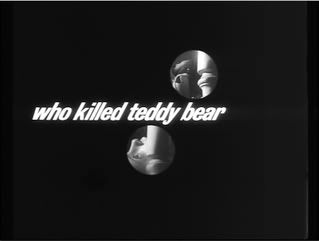
Produced in 1965 and directed by Joseph Cates, Who Killed Teddy Bear? is a Freudian nightmare, a sleazy thriller that transgresses many of cinema’s taboos. In fact, the film’s transgressive quality resulted in the British Board of Film Censors originally rejecting the picture, prohibiting its release to British cinemas. This release from Network marks the first time the film has been commercially available in Britain, and it’s also the film’s first official DVD release anywhere in the world. Who Killed Teddy Bear? is very much a film of its time; the long night club scenes, depicting row after row of young (and sometimes not so young) adults dancing eccentrically, have over time become indexical of early 1960s ‘youth cinema’. These types of scenes were frequently injected into pictures to make them more contemporary and marketable to a youth audience, but since the 1970s the once-topical and controversial night club sequences in pictures such as this have acquired a ‘camp’ status. Nevertheless, even these dated night club sequences cannot defuse the sweaty psychosexual tension that lies at the heart of the film. 
The picture opens with a shot of a young girl. After glimpsing something off-camera, the girl begins to descend a flight of stairs. She falls and screams, and an iris effect is used to pick out the image of her decapitated teddy bear as it lies on the stairs. Disturbed by the ringing of an alarm clock, a man awakens from what was apparently a nightmare. His hand reaches out and turns off the alarm. As he sits on the bed and sensually rubs his side, his torso is framed in a mid-shot; his head and facial features are cropped off the top of the frame. His hands are shown in close-up as he collects a packet of cigarettes from the top of a dressing table, and the strike of a match is heard offscreen; a lurid book, titled ‘When She Was Bad’, also sits on the cabinet. The camera cuts back to the man’s torso as it stands in front of a mirror. Two pictures of a woman (it’s difficult to tell if the images are of the same woman or two different women) are tucked into the side of the mirror’s frame. Facing towards the mirror and the pictures, the man again begins to sensually stroke his body in a way that is clearly intended to signify sexual arousal. The man lays down on the bed, stroking his thigh. After pausing for a moment, he picks up the receiver of the telephone that sits on his bedside dresser and rings a number. A woman answers. The man’s free hand, still perched on his thigh, clenches into a fist. The man does not speak, and the woman puts down the receiver. The man dials again. Another woman, later revealed to be Norah (Juliet Prowse), answers. With a feverish tone in his voice and no less than a hint of desperation, the man whispers ‘I know that you don’t know me, but I know you very well [….] I know what you look like right now. I can see your skin’. 
This opening sequence immediately establishes the film’s psychosexual terrain. Within these opening moments of the film, viewers are subjected to a Freudian ‘primal scene’ which is replayed in a feverish nightmare, pornography and voyeurism, obscene telephone calls and masturbation. In its representation of sexual deviance, the film pushes against the boundaries of the limits set by the Motion Picture Production Code, which in the year of this film’s release was relaxed and only two years later would be abandoned in favour of the age-based classification system that, throughout the late-1960s and 1970s, facilitated the explosion of more openly sexually-explicit and violent pictures. The man depicted in the opening sequence is revealed to be Lawrence (Sal Mineo), a busboy in the nightclub where Norah works as a DJ. Norah is a young woman from Rochester who has moved into the heart of New York; she is a free spirit and independent woman who is happy to live alone despite the nightclub owner Marian Freeman’s (Elaine Stritch) suggestion that it’s not safe (‘I must say, I think you’re stupid living in that silly walk-up by yourself’). Through the dialogue, it is made clear that Norah’s colleagues consider her to be ‘frigid’, and when she fails to heed police lieutenant Dave Madden’s (Jan Murray) suggestion that the obscene caller may be someone she knows, she is warned that ‘Nobody is inviolate, including virgins’. 
Norah returns home; via a point-of-view shot, we watch her undress through a pair of binoculars. She receives another call: ‘Hello, my love. I wanna talk to you [….] I’m a man and I will make you feel like a real woman [….] I know you so well. I know every inch of you so well. I know every area’. The call shocks Norah, and she calls the police. Lieutenant Madden takes a personal interest in her case, and he shows an almost encyclopaedic knowledge of deviant behaviour and sexual perversions. When Madden tells Norah that the caller may be a threat to her life, she reminds him, ‘You said he gets his kicks just out of listening to me react’. Madden responds by stating, ‘I said “most of the time”. With them, you don’t get a guarantee. Why should they be different? Nothing to last, nothing safe? There’s no protection in rules’. Norah sarcastically says ‘Thanks a lot’, and Madden brings her down to earth: ‘What do you want, a fairy tale? That’s how it is. Accept it, and maybe you’ll live to enjoy… whatever you want to enjoy’. Madden advises Prowse that there are many different types of ‘telephone psychotics’: ‘some are fetishists, some are sadists, some are masochists. Then there are the simple voyeurs, the pediophiliacs. But even that’s too neat, somewhat like rules; so then we have the combinations, and I’m not talking about your Uncle Charlie who buys pin-up calendars. I mean the complicated pairing: the sado-masochist, the voyeur-masochist, the exhibitionists, the necrophiliacs’. When Norah tells him, ‘You seem to know a lot about these things’, Madden matter-of-factly declares that ‘Someone should’. The film suggests that Lawrence is a dark shadow of Madden. For a brief period, Norah assumes that Madden’s interest in the darker side of human behaviour might signify that he is in fact her stalker (‘All that talk about perversions, and it was yourself you were talking about. To me you’re an animal. You’ve got a wife and a child at home. You’re a dirty, disgusting animal’). However, Madden reveals that his interest stems from the rape and murder of his wife at the hands of a sexual sadist; the killer had mutilated her corpse ‘after she was dead’, and this is the reason for his interest in ‘perverts’. Madden’s interest in sexually deviant behaviour infiltrates all aspects of his life. Earlier in the film, we are shown him returning home from his shift and playing audio recordings of case studies of women who have been harassed by telephone. The camera pans across his desk, revealing books about sexual disorders, and then cuts into his daughter’s bedroom as she listens through the wall to the recordings that her father is playing. In a later sequence, Norah accuses Madden of being over-protective of his daughter, asserting her need to face the world head-on rather than hide from it: ‘Maybe I am scared now, but not when I was eight and not when I was eighteen. And even now, in spite of this, I’m not going to shut out the world; I’m not going to be forced to become something that has to run and hide in corners, not by him and not by you’. Further parallels are drawn between Madden and Lawrence when, in a scene that echoes Madden’s attempts to shield his daughter from the outside world, Lawrence catches his mentally-challenged sister Edie (Margot Bennett) wearing high-heeled shoes and makeup. Becoming visibly angered, Lawrence accuses Edie of dressing ‘like a whore [….] I don’t wanna see you dressing up like that [….] You let the others dress like that, the ones that wanna tease and they wanna lead you on’. In another sequence, Madden discusses his ‘hobby’ with one of his colleagues. The other detective tells Madden, ‘Can’t you see? That junk you’ve got in your apartment. Did it help you in any way? Or did it just help a ten year old kid talk like a vice squad detective? Dave, you’re over the line. You’ve gone over [….] You’ve joined them’. Confused, Madden asks, ‘Who, the animals?’ In response, Madden’s colleague declares, ‘We’re all animals, Dave. The line I mean divides the sick from the well’. 
In such ways, the film makes a connection between Madden’s interest in deviant sexual behaviour and Lawrence’s sexual repression, suggesting that through exposing his child to literature and discourse relating to sexual crimes Madden may in fact be leading his daughter into becoming as repressed as Lawrence; Lawrence’s overly-protective relationship with his sister Edie finds its mirror in Madden’s overly-protective approach to rearing his daughter. However the film also suggests that other males participate in the same kinds of voyeuristic and exhibitionistic behaviour that marks Lawrence as deviant. In the club where Norah and Lawrence work, the barman sidles up to Lawrence and whispers, ‘Whoah, look at the one in the red. The blonde’. With the man’s words as a cue, a montage of shots of a woman dancing suggestively are shown onscreen. The suggestion is that all men are voyeurs. When, in a verite-style sequence, Lawrence ambles through a red light district, browsing through adult bookstores (whose contents are fetishised by the camera through long, lingering pans across the contents of their window displays) and visiting an ‘adults only’ cinema, he is clearly not alone. Played by Sal Mineo, Lawrence is a handsome young man, his ‘deviance’ hidden from view and, aside from his obscene telephone calls to Norah, only manifesting itself in his sexual repression: of the women in the night club, Lawrence comments, ‘The way they move… the way they’re moving, it’s very suggestive [….] And have you seen their faces, uh? They’re cold, and they’re without any emotion at all’. As Marian tells Norah, ‘You know what I think? I think there’s a little bit of this jerk in every guy, including the cops. Maybe they’ve all got a guilty conscience’. However, there is also ‘a little bit of this jerk’ in Marian, who reveals herself to be a lesbian when she makes a pass at Norah and, when she is rejected, accuses Norah of making up ‘those telephone voices’ and snarls, ‘I went out of my way to be nice to you’. (‘Maybe too nice’, Norah reminds her.) 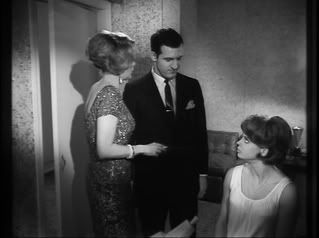
However, despite his obsessive stalking of Norah and his obscene telephone calls, Lawrence is not a cut-and-dried villain: however misguided his actions, he dotes over his sister Edie, and as noted above his relationship with Edie mirrors that of Madden and his daughter. In the scenes set in the nightclub, he is also respectful of Norah and the other female staff—more so than the other male employees, in fact. (In a very early scene, one of the bouncers leers lasciviously at Norah whilst she is in Marian’s office.) His treatment of Edie is revealed to be an outcome of his guilt. The flashbacks reveal that whilst Lawrence was supposed to be taking care of his younger sister, he participated in a sexual liaison with an older woman. Edie witnessed her brother having sex (the primal scene suggested in the opening credits) and, leaving the scene, fell down the stairs. Her childish mental state is suggested to be an outcome of her accident, although in line with the Freudian nature of the film it could also be interpreted as a result of trauma at witnessing her brother’s sexual encounter with a woman who, on her first appearance, is coded as a mother figure. (When Lawrence later visits an adult bookstore, the camera picks out books on incest, perhaps highlighting that his encounter with the older woman was the manifestation of an Oedipus complex; interestingly, Edie and Lawrence’s parents are curiously absent from the flashbacks.) The primal nature of the flashbacks is signified through the way in which, during these analepses, the extreme edges of the frame are distorted or blurred. The decapitated teddy bear, which is symbolic of Edie’s accident, is planted by Lawrence in Norah’s home, an ambiguous action which could suggest (counter to Madden’s claims that the telephone calls will escalate into an explosion of sexual violence) that on some level, Lawrence sees Norah as a substitute for his sister Edie, who is a similar age to Norah; perhaps Lawrence sees Norah as the woman Edie should have developed into. The nature of Lawrence’s obsession with Edie is left tantalisingly ambiguous; presumably Lawrence himself cannot rationalise his own desire for Norah. 
Who Killed Teddy Bear? is a strikingly effective thriller, a psychosexual circus that is, in its narrative of obsession and its verite-style shots of Lawrence prowling through the city streets, a contemporary of both 1960s films noirs such as Blast of Silence (Allen Baron, 1961) and Experiment in Terror (Blake Edwards, 1962) and the no-budget ‘roughies’ that were already beginning to circulate in America’s less reputable movie houses, such as The Defilers (Lee Frost, 1965) and The Touch of Her Flesh (Michael Findlay, 1967). The film’s exploration of voyeurism and sexual repression also brings to mind both Psycho (Alfred Hitchcock, 1960) and Peeping Tom (1960), and the climax in a room full of mirrors seems to visually allude to Orson Welles’ The Lady From Shanghai (1947). The device of Lawrence’s telephone calls—made in a desperate, feverish tone of voice—recalls Experiment in Terror and anticipates the use of feverish, taunting telephone calls as a narrative device in many Italian thrillers (thrillings all’Italiana or, as they have come to be known by English-speaking fans, gialli), such as The Bird With the Crystal Plumage (Dario Argento, 1970) and The New York Ripper (Lucio Fulci, 1982); the device would later become common in American ‘bodycount’/‘slasher’ films, from Black Christmas (Bob Clark, 1974) to Scream (Wes Craven, 1996). As such, Who Killed Teddy Bear? is a fascinating little film that should have something to appeal to most modern fans of transgressive 1960s cinema. 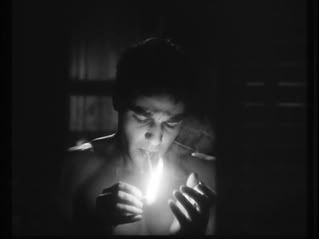
Video
The film is presented in a fullframe ratio (of 1.33:1). Although as a commercially-released film made after the 1950s it would most likely have been shown in American cinemas at a ratio of 1.85:1 or thereabouts, the transfer on this DVD does not seem to suffer from any cropping and so I would infer that it is probably an open-matte transfer of the movie. There is some noticeable print damage which appears from time to time, principally vertical scratches in the celluloid that have presumably been caused by wear and tear from projectors. However, the monochrome image is crisp and detailed, with good gradation in the greys. On the whole, it’s a very pleasing presentation of the film. The film’s running time is 86:47 mins (PAL), and there do not appear to be any edits. 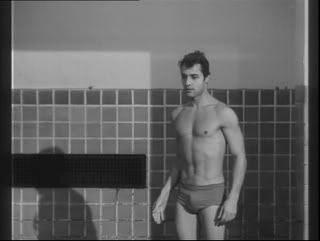
In the past, two versions of the film have been in circulation via screenings on US television and revival screenings in cinemas. The shorter variant edit of the film cuts short the sequence set in the Hudson Health Club. In this three minute-long sequence, Lawrence is shown exercising in the Hudson Health Club. The sequence begins with a shot of Lawrence's torso as he works on a machine, the machine's pistons pounding up and down symbolically. Lawrence is then shown swimming in a pool, where he is approached by Norah, who compliments him on his physique ('I think everyone should work out. You have a very nice body [....] I don't like it when men let themselves get fat'). This sequence is intact on this DVD, suggesting that Network’s release seems to contain the longest version of the film. However, some online sources (for example, the Internet Movie Database) cite the film's running time as 94 minutes. Even accounting for PAL speed-up, this release from Network is still around four minutes shy of that length. On the other hand, the inclusion of the full Hudson Health Club sequence, not to mention some fairly explicit content during Lawrence's tour of the adult bookshops and cinemas, would seem to suggest that this film hasn't suffered any cuts. Thus we may infer one of two things: the 94 minute running time may be erroneous (and, to be fair, it wouldn't be the first time that an incorrect running time was listed on the IMDb), or there may be some material missing from this release. At this juncture, it's impossible to determine with any certainty which of these hypotheses is correct.
Audio
Audio is presented via a two-channel monophonic track. Like the image, this is crisp and clear. There are no subtitles.
Extras
The DVD includes an abundance of extra features, including: - an effective little trailer for the film (2:09), which highlights the ‘youth’ elements of the film and also its qualities as a thriller; - an image gallery of lobby cards and stills (4:07); - an episode of Court Martial entitled ‘The House Where He Lived’ (48:03). An ITC production, Court Martial was shot at Pinewood Studios and was broadcast in 1966. The show featured Peter Graves and Bradford Dillman investigating military crimes, each episode focusing on a different case. The episode on this DVD features Sal Mineo in a supporting role, along with Anthony Quayle and, in a small role, Frank Wolff; - a short public service film, ‘LSD: Insight or Insanity?’ (18:07). Made in 1967 and narrated in hardboiled, staccato fashion by Sal Mineo, this film focuses on teenage life (‘teenagers have always shared one thing in common: they have always found a unique way to express themselves […] and this would be called “group self-expression”’). The film discusses teenage fashions before beginning to focus on the perils of drugs, from marijuana to LSD (‘Now that’s the real stuff. Very, very cool. Very, very groovy’, Mineo intones ironically). The experience of an LSD trip is presented as a nightmare (‘Give yourself a real kick. Yes, a kick in the head’), and scientists provide a history of LSD and its origins in attempts to find new drugs with which to treat migraines; they also discuss its potential long-term effects, along with the ways in which the drug’s symptoms simulate the effects of ‘some forms of insanity, in particular schizophrenia’ and its tendency to force subjects to ‘recall in terrifying detail incident that are long forgotten’. Also highlighted is the drug’s role in temporarily disabling subjects’ understanding of cause-and-effect relationships, leading ‘to a distortion of judgement’.
Overall
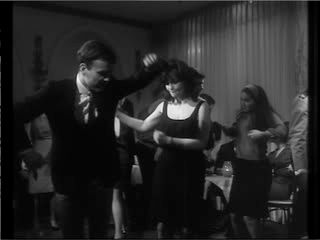
Who Killed Teddy Bear? is a delight of a film, especially for fans of transgressive cinema. This DVD release, which represents the film’s first commercial release in the UK and the first DVD release of this film in any country, is welcome and the abundance of fascinating contextual material, including the episode of Court Martial, means that this disc comes with the strongest recommendation. For more information, please visit the homepage of Network DVD.
|
|||||

|